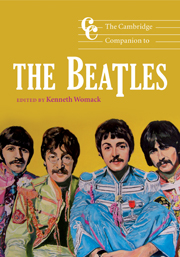Book contents
- Frontmatter
- Introducing the Beatles
- Part I Background
- Part II Works
- 3 Rock and roll music
- 4 “Try thinking more”: Rubber Soul and the Beatles' transformation of pop
- 5 Magical mystery tours, and other trips: yellow submarines, newspaper taxis, and the Beatles' psychedelic years
- 6 Revolution
- 7 On their way home: the Beatles in 1969 and 1970
- 8 Apple Records
- 9 The solo years
- 10 Any time at all: the Beatles' free phrase rhythms
- Part III History and influence
- Notes
- Beatles discography, 1962–1970
- Select bibliography
- Index
5 - Magical mystery tours, and other trips: yellow submarines, newspaper taxis, and the Beatles' psychedelic years
from Part II - Works
Published online by Cambridge University Press: 28 September 2011
- Frontmatter
- Introducing the Beatles
- Part I Background
- Part II Works
- 3 Rock and roll music
- 4 “Try thinking more”: Rubber Soul and the Beatles' transformation of pop
- 5 Magical mystery tours, and other trips: yellow submarines, newspaper taxis, and the Beatles' psychedelic years
- 6 Revolution
- 7 On their way home: the Beatles in 1969 and 1970
- 8 Apple Records
- 9 The solo years
- 10 Any time at all: the Beatles' free phrase rhythms
- Part III History and influence
- Notes
- Beatles discography, 1962–1970
- Select bibliography
- Index
Summary
The day of the LSD experience often becomes a dramatic and easily discernible landmark in the development of individual artists.
stanislav grofOne evening in April of 1965, Beatles George Harrison and John Lennon, Along with George's fiancée Pattie Boyd, and John's wife Cynthia, dined with John Riley, a prominent dentist in London. Their host secretly slipped LSD-laced sugar cubes into the after-dinner coffees, and so began a night filled with bouts of intense sensory excitement. Lennon later exhorted listeners to “take a drink from [the] special cup” of a physician named “Doctor Robert,” a song on which dreamy, seemingly floating vocal harmonies declared: “well, well, well, you're feeling fine,” quite likely commemorating the quaffing of their first and subsequent magic cups. In August of that same year, Harrison and Lennon again took LSD; this time, Ringo Starr joined in, as did actor Peter Fonda. As Harrison sat poolside, struggling somewhat with the effects of the drug, Fonda related a story from his youth in which he nearly died from blood loss. “I know what it's like to be dead,” he stated. Lennon, perhaps in an effort to free the group from the morbid impact of Fonda's story, retorted: “Who put all that shit in your head?” Lennon memorialized this event in “She Said She Said,” a track on which he changed the sex of his interlocutor and related that: “She said I know what it's like to be dead … / I said who put all those things in your head.”
- Type
- Chapter
- Information
- The Cambridge Companion to the Beatles , pp. 90 - 111Publisher: Cambridge University PressPrint publication year: 2009
- 3
- Cited by



